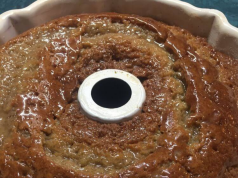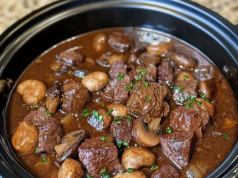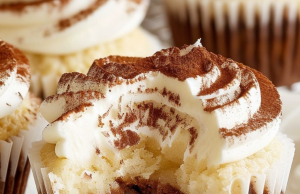A nostalgic, velvety dessert passed down through generations—this old-fashioned tapioca pudding is rich, comforting, and made the way my Nana and aunties used to make it when I was young. With plump, translucent pearls suspended in a silky custard of milk, cream, vanilla, and just a hint of sweetness, every spoonful tastes like childhood on a spoon.
Why You’ll Love This Recipe
This isn’t just pudding—it’s family history in a bowl. For years, this recipe lived only in memory, never written down. My Nana would stir it slowly on the stove, her wooden spoon scraping the pot as she hummed softly. The kitchen would fill with warmth and the sweet scent of vanilla, and we’d wait—barely able to stand still—for that first cool, creamy bite.
Now, after testing and tasting until it tasted just right, I’ve captured that magic in writing. It’s simple, slow-cooked comfort: tender tapioca pearls, a smooth custard base, and no shortcuts. Whether you grew up with this or are discovering it for the first time, one spoonful will feel like home.
Perfect for:
- Late-night snacks
- Holiday desserts
- Meal prep (it keeps beautifully)
- Passing down to your own kids
Ingredients
- 1 cup cold water (for soaking)
- ½ cup (90g) small tapioca pearls (not quick-cooking or instant)
- ½ cup (100g) granulated sugar (adjust to taste)
- 1 cup (240ml) half-and-half (or light cream)
- 2 cups (480ml) whole milk
- ⅛ tsp salt (just a pinch—balances sweetness)
- 2 large eggs, lightly beaten (acts as thickener and enricher)
- 1 tsp pure vanilla extract (added at the end for freshness)
Step-by-Step Instructions
1. Soak the Tapioca
In a medium bowl:
- Combine tapioca pearls and 1 cup cold water.
- Let soak at least 30 minutes, or up to 1 hour.
2. Heat the Dairy
In a medium saucepan over medium heat:
- Add half-and-half and milk.
- Warm gently until steaming and just about to simmer—do not boil. Stir occasionally to prevent scorching.
3. Cook the Tapioca
- Drain soaked tapioca and add to the warm milk mixture.
- Stir in sugar and salt.
- Cook over medium heat, stirring frequently, for 15–20 minutes, until:
- Mixture thickens slightly
- Tapioca pearls turn translucent with no white center
4. Temper the Eggs
In a small bowl:
- Lightly beat the eggs.
- Slowly ladle about ½ cup of the hot tapioca mixture into the eggs, whisking constantly—this raises the temperature without cooking them.
5. Thicken the Custard
- Pour the tempered egg mixture back into the saucepan.
- Cook over medium-low heat, stirring constantly, for 3–5 minutes more, until the pudding coats the back of a spoon.
6. Finish & Chill
- Remove from heat.
- Stir in vanilla extract.
- Pour into a large bowl or individual ramekins.
- Cover surface directly with plastic wrap (to prevent skin).
- Refrigerate at least 2 hours, preferably 3–4 hours, until fully chilled and set.
Serve cold.
You Must Know
- Use small pearl tapioca —not instant or bubble tea size.
- Soaking is essential —unsoaked pearls take much longer to soften.
- Stir constantly during cooking —custard burns easily.
- Cover the surface —plastic wrap touching the pudding stops a rubbery film.
- Make ahead? Yes—tastes even better the next day!
Storage Tips
- Store covered in the fridge for up to 4 days.
- Do not freeze —texture becomes grainy upon thawing.
- Stir gently before serving if liquid separates slightly.
Ingredient Substitutions
|
Half-and-half
|
Heavy cream or whole milk
|
Richer or lighter version
|
|
Whole milk
|
2% or oat milk
|
Slight texture change
|
|
Sugar
|
Coconut sugar or maple syrup
|
Adjust amount—liquid sweeteners change consistency
|
|
Eggs
|
Cornstarch slurry (1 tbsp + 2 tbsp cold water)
|
Not traditional, but works for egg-free
|
|
Vanilla extract
|
Vanilla bean paste or ½ scraped pod
|
More intense flavor
|
Serving Suggestions
- Top with a dollop of whipped cream and a sprinkle of cinnamon.
- Serve in vintage glasses for a retro touch.
- Layer with fresh berries for a parfait.
- Pair with pie or coffee cake for dessert.
Cultural Context
Tapioca pudding has roots in both British colonial cuisine and Caribbean kitchens, where cassava-based starches were adapted into creamy European-style desserts. Found in American diners, school cafeterias, and family homes alike, it’s a humble dish that speaks of care, patience, and love. This version honors those who cooked without recipes—by feel, by memory, by heart.
Pro Tips
- Double the recipe? Yes—perfect for potlucks or freezing (well, sort of—see storage).
- Want it thicker? Cook a minute or two longer or add an extra egg yolk.
- Label your dish: People will ask for the recipe.
- Say “ready?” before serving —it’s part of the ritual.
Frequently Asked Questions
Q: Can I use instant tapioca?
A: No—this recipe relies on small pearls that need soaking and slow cooking.
Q: Why did my pudding turn out watery?
A: Likely undercooked or not enough egg. Cook until it coats the spoon.
Q: Is this gluten-free?
A: Yes—tapioca is naturally GF. Just verify all labels.
Q: Can I make it on the stovetop only?
A: Absolutely—this is the traditional method!
Q: Can I add raisins?
A: Of course! Stir in ¼ cup during the last 5 minutes of cooking—the classic move.
Allergy Information
Contains: dairy (milk, half-and-half), eggs.
Gluten-free: Yes (if using certified GF ingredients).
Nut-free: This recipe is naturally nut-free.
Always check labels—especially on dairy products and vanilla.
Nutrition Facts (Per Serving – Approximate)
Based on 6 servings
- Calories: 220
- Fat: 8g
- Saturated Fat: 4g
- Carbohydrates: 30g
- Fiber: 0g
- Sugar: 20g
- Protein: 6g
- Sodium: 110mg
This pudding doesn’t shout. It sits quietly in the fridge, cool and creamy, saying everything a great dessert should: “Scoop me slow. Share me. This is good.” That’s how the best ones begin—not with words, but with water, pearls, and someone who says, “Let’s make it the way we remember.”










